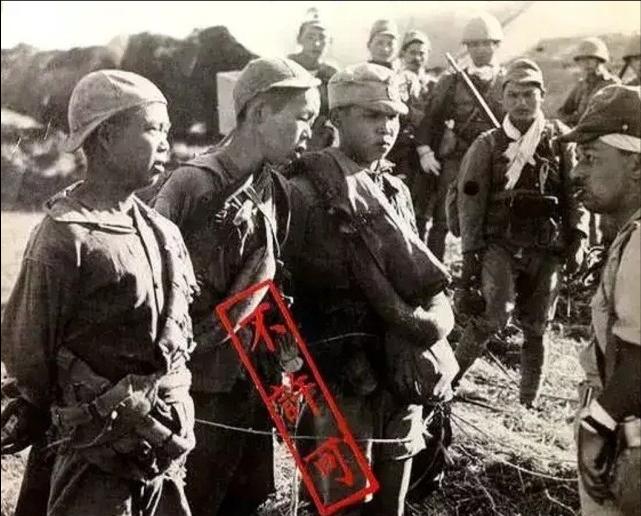History has its own life, it is like a person, both easy-going and self-respecting. ——Yu Qiuyu

After the July 7 Incident in 1937, the reporters accompanying the Japanese Daily News took a large number of photos of the Japanese invasion of China. Although this was a means for the Japanese military to create public opinion and hoodwink the people at home, in order to prevent the possible impact of some photo releases on the Japanese army, the Japanese army strengthened the press censorship system. Except for photographs involving military secrets, no photographs that damage the positive image of the Japanese army or may cause war-weariness in Japan are not allowed to be published. The picture shows the Chinese Boy Scouts captured by the Japanese army. This photograph reflected the cruelty of the war, considering that it would trigger anti-war sentiment in the country, so it was judged by the Japanese army as "not allowed".
After Japan's defeat in 1945, the Japanese military ordered that "all photographs taken in the battlefield should be burned", but the Daily News quietly hid these photos and negatives in the basement. From 1977 to 1998, the Mainichi Shimbun compiled and published them in a volume. As a result, these precious historical materials that record the ironclad evidence of the Japanese invasion of China can be seen again. Pictured here at the Tianjin Railway Station, an arrested Chinese plainclothes man is tied to a pillar.
Japanese soldiers preparing to disguise themselves as Chinese civilians. Their task was to reconnoiter the deployment of the Chinese army for the large Japanese troops. Considering that it was detrimental to the image of the Japanese army, it was judged to be "not allowed".
Japanese spies in the trenches looking out for Chinese troops.
Japanese soldiers disguised as Chinese civilians were reconnaissance on the banks of the Yellow River.
On August 13, 1937, the Sino-Japanese Battle of Songhu broke out. The Japanese bound Chinese soldiers captive with wire, and a Japanese soldier armed with a bayonet is guarding them. Considering the restrictions of the Geneva International Conventions, the Japanese army was afraid that the mistreatment of prisoners of war would cause a chain reaction, so it judged them to be "not allowed" photos and not allowed to publish them.
Several Japanese soldiers transported ammunition in stolen ox carts. Although the three words "Review Ji" in the upper right corner of the picture indicate that this photo can be published, after being reviewed by the Japanese army, it is considered that this photo is suspected of recording the robbery of the Japanese army, so it is still listed as an "unlicensed" photo.
Bury the Japanese soldiers who died in battle. Considering that the publication of this photo will cause soldiers to be war-weary, it was judged to be "not allowed" after review by the Japanese army.
During the Battle of Songhu, Japanese combat troops brutally killed captured Chinese troops, taking into account the Geneva International Convention and the so-called Sino-Japanese goodwill of the Japanese.
After the Outbreak of the Battle of Songhu, Nanjing Road in Shanghai was bombed by the Japanese army.
After the Battle of Songhu, the Japanese army immediately advanced towards Nanjing. The picture shows the Japanese troops preparing to cross the river.
Chinese soldiers killed on the streets. Reflecting the cruelty of the war, he was judged by the Japanese army to be "not allowed".
The picture shows the surviving citizens of Nanjing after the Japanese air raid, and they have become a ruin next to them.
After the air raid, corpses were strewn across the city. In order to disguise the civilian casualties caused by the large-scale bombing of non-military facilities in Nanjing by the Japanese army, all photographs related to the air raids in Nanjing were not allowed to be published.
The Rockefeller Institute in Nanjing after the Japanese bombing. At that time, Japan did not turn its face with Britain, the United States and other countries, and considering diplomatic issues, Japanese military censors judged it as "not allowed."
After the Japanese air raids, many parts of Nanjing City were in disarray.
Japanese officers riding Toyo horses into the city.
On December 13, 1937, the Japanese army captured Nanjing. Subsequently, the Japanese army launched a burning and looting of Nanjing. The picture shows Japanese soldiers carrying looted supplies. Considering that this photo will not only affect the image of the Japanese army after it is transmitted back to Japan, but also cause resentment among the domestic public, the Japanese military censorship team judged it to be an "unlicensed" photo.
The road of history is full of twists and turns, and there is a lesson: "Conscientious and strong, the wind is the death"; "the prosperity is not sluggish, and strive to be strong". Only by keeping history in mind, taking history as a mirror, and being brave after knowing shame can we make our motherland prosperous and forever stand tall in the east of the world!